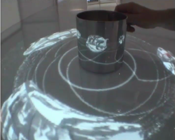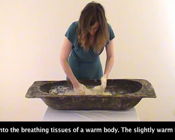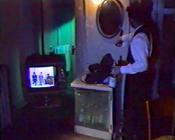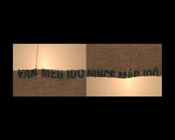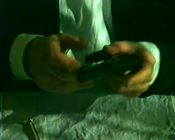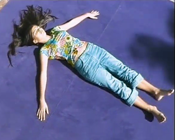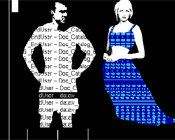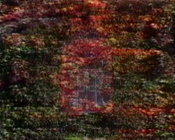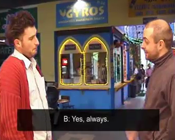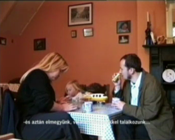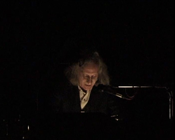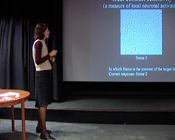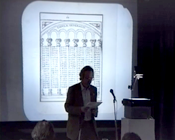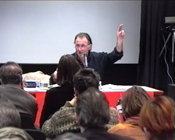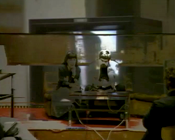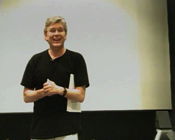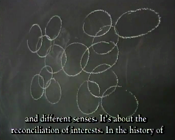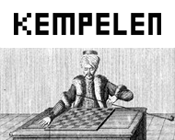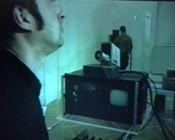FEATURED ARTWORKS
-
Márton Fernezelyi, Zoltán Szegedy-Maszák: Aura. Reflections on a Table (2003 – 2005)
documentation / installation art / interactive artThis interactive installation is based on the phenomena of cylindrical anamorphosis. Distorted circular pictures projected around the chrome steel cup standing on the top of a table, showing its virtual surroundings. On the projection surface, these images are chaotic and incomprehensible. But when reflected on the surface of the mug, they form coherent moving images, representing the fictional environments of the object. As the visitor drags the mug on the tabletop, the projected anamorphic image follows its movements, showing different views of its virtual environment, just like it would reflect its real surroundings. more... -
Erika Baglyas: Useful Knowledge (2006 – 2007)
video artIn the ’Useful knowledge’ video installation we can see a women, the artist herself. She is kneading dough. The viewer can not see, therefore can not understand the technique of preapering the dough. There is a technique indeed, the learning of which was a useful, neseccary and indispensable knowledge once. In the movie I talk about the personal experience of kneading. Kneading is like a meditation. The woman almost unifies with the thing she is concentrating on. Unconsciously she locks out the environment and becomes empty. The luckwarm dough sticks to the skin. more... -
Gábor Bódy: Either/Or in Chinatown (1984)
video artIn the '70s there was much criticism of the photographic representation of reality. That was the start of my experiments in film theory. This was an analytical period for me. Now I don't think so analytically, but more creatively and expressively, to use the language freely to give to people and tome. For me it is clear that the images are something other than reality. The pictures are indices of reality but not the same as reality. The frame is selected and edited, and you can talk about these things as though they are reality, but it is not the same. more... -
Lajos Csontó: Don't Be Afraid! (2006)
video artThe video, which bears mythological references, reflects on the story of Penelope and Odysseus and the subjective nature of our perception of time. A simple coarse knitting constitutes the surface of the picture, on which the following inscription can be read: "There is still time" and "There is no longer time". The video is made up of two images, one of which shows the unraveling of the surface of the knitting while the other depicts its re-stitching. The hand of the person unraveling it is not visible; thereby producing the effect of an hourglass which when turned upside down is controlled by the laws of gravity. more... -
Gusztáv Hámos: Killer (1986)
video artThree interviews with three murderers. The assignment of one of the hit-men is to liquidate a film hero and the implementation requires the meeting of electronic sign and celluloid. The multi-layeredness of the use of analog video technique offers a glimpse into the thoughts of hit-men and sheds light on the fact that the Aristotelian theory of catharsis comes with an excess of agitation. In the best of all possible circumstances a professional hit-man therefore avoids any kind of confrontation with emotions. more... -
Tamás Komoróczky: The Name of the Code: UUUU (2003)
video artThe song performed by Naila invites us to an ironic meditation by comparing humans to a computer programme. The spinning and monotonous rotation illustrates how someone, whose has been deprived of his personality, can loosen up, which can also be seen as the extension of time and space of the circle looking into itself. In accordance with the music, close- and total-shots are alternating of the calm clouds and the girl lying with her arms wide open, while the ground rotates sometimes fast, sometimes slow. more... -
Olia Lialina: Agatha Appears (1997)
network artThe work presents the dialogue between a system administrator just fired and Agatha, a lost country girl. SysAd reveals the tremendous possibilities of this new vehicle – the Internet which transcends the space and time. Through Agatha's hypertext global journey from one place into another Olia Lialina investigates the non-linear and decentralized structures of the Net. more... -
Anita Sárosi: Map (1997)
video artThe video work was inspired by a peepshow of one of Rembrandt's pupils, Samuel von Hooghstraten. Originally in order to achieve an effect of spatial illusion, pictures with exaggerated perspectives were used in these boxes. Later cut-out coulisse images were placed at varying depths in order to create a genuine impression of space. The video, by breaking the two dimensional pictures into planes and applying the rules of central perspective, invites us to stroll through a world that uncovers yet paradoxically also confirms the illusions. more... -
Katarina Šević: Easy and Fast – Hungarian (2004)
installation artThe video installation is based on the Hungarian language book having the same title, which was published five times from 1965 to 1995 in Novi Sad, Yugoslavia. Despite of the radical social and political transformations of the region during those three decades, only the last edition of the book was updated: one single lesson, titled "In the factory" became "Businessman". These facts were the starting point for the storyboard of the video. Using similar language expressions of the book, the author wrote the dialogues based on her own personal experiences that took place in public spaces. more... -
Pál Szacsva y: I'm Home When I'm Not (1997)
video art / installation artOn the course of the action, I focused on the feeling of being at home in the flats of total strangers. I approached the residents of Hull, England on the telephone, in the street and other public spaces, asking them to let me in into their homes so that I could perform an everyday task of their suggestion there. (...) My activities were recorded on video by my hosts. In the installation, television sets positioned as traps showed in a loop video recordings of the moment of asking “permission for entry”. more... -
Márton Fernezelyi, Zoltán Szegedy-Maszák: Aura. Reflections on a Table (2003 – 2005)
documentation / installation art / interactive artThis interactive installation is based on the phenomena of cylindrical anamorphosis. Distorted circular pictures projected around the chrome steel cup standing on the top of a table, showing its virtual surroundings. On the projection surface, these images are chaotic and incomprehensible. But when reflected on the surface of the mug, they form coherent moving images, representing the fictional environments of the object. As the visitor drags the mug on the tabletop, the projected anamorphic image follows its movements, showing different views of its virtual environment, just like it would reflect its real surroundings. more... -
Erika Baglyas: Useful Knowledge (2006 – 2007)
video artIn the ’Useful knowledge’ video installation we can see a women, the artist herself. She is kneading dough. The viewer can not see, therefore can not understand the technique of preapering the dough. There is a technique indeed, the learning of which was a useful, neseccary and indispensable knowledge once. In the movie I talk about the personal experience of kneading. Kneading is like a meditation. The woman almost unifies with the thing she is concentrating on. Unconsciously she locks out the environment and becomes empty. The luckwarm dough sticks to the skin. more...
FEATURED CREATORS
-
Zoltán Szegedy-Maszák (1969 – )
Born in Budapest. Professor, vice rector, media artist. He graduated at the Hungarian University of Fine Arts (MKE, formerly Hungarian Academy of Fine Arts) in painting, his teachers were Gábor Nagy and Dóra Maurer (1988/92). He gave lectures of computer studies at the Intermedia Department (1992) and he earned a degree in intermedia (1994) together with his postgraduate studies (1992/94). He taught computer-animation at the Hungarian Academy of Applied Arts (1994/95). more...Aura [documentation / installation art / interactive ar ]
Camouflage [documentation / installation art / interactive art]
Cryptogram [computer art / installation art / network art]
Oculus Artificialis Teledioptricus 2.0 [doc. / installation art / interactive art]
Open Work [installation / video art]
Promenade [documentation / installation art / interactive art]
Smalltalk [documentation / installation art / interactive art]
Visual Communication [documentation / installation art / interactive art]
more... -
Gábor Bódy (1946 – 1985)
Born in Budapest. Studied philosophy and history at the Eötvös Lóránd University (ELTE), Budapest (1964/71), thesis title: ’The Investigation into the meaning structures of film: The attribution of film making.’ Even as a student, he writes screen plays and participates in filmmaking (‘Agitators’, 1969, directed by Dezső Magyar). His makes his debut in 1971 (‘The Third’), at which point he becomes a member of the Béla Balázs Studio (BBS). He studies film and stage directing at the Academy of more...Conversation between East and West [video art]
Dancing Eurynome [video art]
De occulta philosophia (2nd version) [video art]
Either/Or in Chinatown [video art]
Novalis: Walzer [video art]
Siblings [video art]
The Demon in Berlin [video art]
The Hostage [video art]
more... -
Eike (1966 – )
Born in Halle, formerly in DDR. Lives and works in Budapest. He studied philosophy in Braunschweig (1986/87) and recieved his B.F.A. degree from the College of Fine Arts in Braunschwieg as well (1987/1992), where he completed the Master's programme with Prof. G. Büttenbender (1992/93). Since 1992 he is board-member of the Stúdió – Young Artists Association in Budapest. Amongst his organizational, curator work, his involvement in the establishment of the Trafó Gallery is more...Contraction [documentation / installation art]
Golden Cage [documentation / installation art]
Past Cuts [documentation / installation art]
The Corner in My Mind [documentation / installation art]
The Stage [documentation / installation art / interactive art / sound art]
The Tunnel [documentation / installation art]
Tuning 3.0 [documentation / installation art]
Windows 2 [documentation / installation art]
more... -
Gusztáv Hámos (1955 – )
Born in Budapest. He is a media artist, in 1979 he emigrated to West-Berlin, and has lived and worked in Berlin since then. In the few years leading up to that, starting from 1974, he was an active participant in the Hungarian underground art world, and was part of several conceptual exhibitions in Budapest, the Netherlands and East-Berlin. Aside from photographs, he also created Super 8 and 16 mm films. He received his diploma from the German Academy of Film, and during more...Except Marci [video art]
Killer [video art]
Mediamatic [video art]
Snow White [video art]
Superman [video art]
The Fiction of [His] Existence [video art]
The Last Day: 1984 [video art]
Transposed Bodies [video art]
more... -
Szabolcs KissPál (1967 – )
Born in Marosvásárhely/Tîrgu Mureş. Studies at the Academy of Visual Arts – Cluj (Romania) between 1986-92. Editor of the journal Jelenlét (Writers’Association Cultural Weekly) 1990-92. Lecturer at the Academy of Visual Arts – Cluj 1992-93. Postgradual studies (MFA) at the Hungarian Academy of Fine Arts at the Painting Faculty (1993-94) and the Intermedia Department (1997-98). KsPál has been artist-in-residence within the EMARE (European Media Artist in Residency Exchange) more...Edging [video art]
Grey [video art]
Halfway to NW [video art]
L'autre monde [video art]
Rever I. [video art]
The Dance [video art]
The Healed km [video art]
Wish [video art]
more... -
Tamás Komoróczky (1963 – )
Born in Békéscsaba (Hungary). He is a media artist, painter. Lives and works in Berlin and Budapest. He graduated at the Hungarian Academy of Fine Arts (MKF) in painting (1986/90) then he studied at the Video Departement of the Staatliche Kunstakademie Düsseldorf (1991). He is a founding member of Tűzoltó 72 Exhibition Place (1990/96), of the Újlak Group (1995) and of the the U.F.F. Gallery (1997). He was an assistant professor of the Painting Department at the MKF and he more...Girls (Bernadett, Eszter, Orsi) [video art]
Lullaby [video art]
OCD – Brain [video art]
OCD – Reports [video art]
raka_tiki_taki_tao_tö_ki... [video art]
The Name of the Code: UUUU [video art]
Then Nothing Else but the Buzzing of the Bees (excerpt) [video art]
Things Fall Out Now This Way, Now That... [video art]
more... -
Antal Lux (1935 – )
CBorn in Budapest, lives and works in Berlin. During the 1956 Revolution, member of the resistance group “The Invisible of Mecsek.” When the revolution is crushed, he flees to Germany. He earns his degree in painting and graphics from the Staatliche Akademie der bildenden Künste in Stuttgart in 1965 on an American scholarship. He participates in the graphics workshop in the Art Colony of Makó (1980/90). As of 1980, in parallel to working as a painter and graphic artist, he also more...Grimace [video art]
Holle [video art]
Hydrographik [video art]
Negotiations [video art]
The Escape [video art]
The House [video art]
The Oath [video art]
Walled souls [video art]
more... -
Dóra Maurer (1937 – )
Born in Budapest. She studied graphics and painting at the Hungarian Academy of Fine Arts (1955-1961). She received a scholarship to Vienna in 1967 and till 1996 has been living in Vienna and Budapest, since 1996 only in Budapest. She is a member of Béla Balázs Studio (1973) and starting from the same year she directed several experimental films ('Learned Spontaneaus Movements', 1973; 'Relative Swingings', 1973; 'Timing', 1973/80; 'Proportions', 1979; 'Triolets', 1980/81; more...Kalah [experimental film]
Learned Spontaneaus Movements 1 - 4 [experimental film]
Looking for Dózsa [experimental film]
Painting the Space, Project Buchberg [experimental film]
Proportions [experimental film]
Relative Swingings [experimental film]
Seven Trials [experimental film]
Timing [experimental film]
more... -
Anita Sárosi (1972 – )
She was born in Gyöngyös. She did her secondary studies at the Art School of Nyíregyháza in the Graphic Design Program (1987/91). She received her degree from the University of Applied Arts in the Video Program (1991/97). After finishing her studies in 1997, she is a guest at the Media Master Art Forum in Stuttgart (1997), and from this year on she is a member of the Béla Balázs Studio, where she will become member of the executive board (1998/97). She teaches at the more...Avatar [video art]
Dragon [video art]
HOME [video art]
I Love My Pyjamas [video art]
INRI [video art]
Map [video art]
Sallanita [video art]
ViewPoint [video art]
more... -
János Sugár (1958 – )
Born in Budapest. He graduated at the Department of Sculpture of the Hungarian Academy of Fine Arts (1979/84). He was actively involved in the exhibitions and performances of INDIGO, an interdisciplinary art group, led by Miklós Erdély (1980/86). He has participated in national and international exhibitions since 1980 and has also created several performances, films and videos. He was one of the executive board members of the Béla Balázs Studio (1990/95). He is an more...Ariadne Unemployed [video art]
Check Your Six [video art]
Do You Know My Method? [video art]
Kamera a pácban [video art]
Monstrance Model / Narcissus in the Black Hole [installation / interactive art]
Nothing Is Like it Used to Be [video art]
The Immortal Culprits [video art]
Typewriter of the Illiterate [video art]
more... -
Pál Szacsva y (1967 – )
Born in Marosvásárhely/Târgu Mureş, Romania. Lives and works in Budapest. He earns his degree at the Ioan Andreescu Academy of Visual Arts in Kolozsvár/Cluj-Napoca (today University of Art and Design, 1988/93). He pursues his postgraduate training at the Hungarian Academy of Fine Arts (today: Hungarian University of Fine Arts, MKE, 1993/95) and at the École Supérieure des Beaux-Arts in Marseille (1996). He then spends one year as a researcher at the Kunsthochschule Berlin more...126 News [video art]
A Walk through Empire [video art]
Air Parade and Fire Works [video art]
Another Finger Exercise [video art]
I'm Home When I'm Not [video art]
Night Shots Here and There [video art]
Pericycle [video art]
Watch Your God [video art]
more... -
Zoltán Szegedy-Maszák (1969 – )
Born in Budapest. Professor, vice rector, media artist. He graduated at the Hungarian University of Fine Arts (MKE, formerly Hungarian Academy of Fine Arts) in painting, his teachers were Gábor Nagy and Dóra Maurer (1988/92). He gave lectures of computer studies at the Intermedia Department (1992) and he earned a degree in intermedia (1994) together with his postgraduate studies (1992/94). He taught computer-animation at the Hungarian Academy of Applied Arts (1994/95). more...Aura [documentation / installation art / interactive ar ]
Camouflage [documentation / installation art / interactive art]
Cryptogram [computer art / installation art / network art]
Oculus Artificialis Teledioptricus 2.0 [doc. / installation art / interactive art]
Open Work [installation / video art]
Promenade [documentation / installation art / interactive art]
Smalltalk [documentation / installation art / interactive art]
Visual Communication [documentation / installation art / interactive art]
more... -
Gábor Bódy (1946 – 1985)
Born in Budapest. Studied philosophy and history at the Eötvös Lóránd University (ELTE), Budapest (1964/71), thesis title: ’The Investigation into the meaning structures of film: The attribution of film making.’ Even as a student, he writes screen plays and participates in filmmaking (‘Agitators’, 1969, directed by Dezső Magyar). His makes his debut in 1971 (‘The Third’), at which point he becomes a member of the Béla Balázs Studio (BBS). He studies film and stage directing at the Academy of more...Conversation between East and West [video art]
Dancing Eurynome [video art]
De occulta philosophia (2nd version) [video art]
Either/Or in Chinatown [video art]
Novalis: Walzer [video art]
Siblings [video art]
The Demon in Berlin [video art]
The Hostage [video art]
more...
FEATURED EVENTS
-
Siegfried Zielinski: Speed and Energy
lecture (1998. 03. 26.)As a special guest of C3, media archaeologist Siegfried Zielinski will make his presentation zapping back and forth between the avant-garde of the 1920's and our present-day technological frontier, with a multi-textural examination of the shifting borders of cutting-edge science and art. Within the lecture excerpts of the following films, among others, will be presented: Viking Eggeling: Diagonal Symphony; Walter Ruttmann: Opus (II-IV); Férdinand Leger: Le Ballet Méchanique; Dziga Vertov: Man with a Movie Camera; Luis Bunuel/Salvador Dalí: Un Chien Andalou. more... -
Ilona Kovács: Capturing Time: From E. J. Marey to Modern Neuroscience
lecture (2010. 10. 20.)How does a good representation of the intricate movements of living things look like? Can we turn all movements of biological origin visible and measurable in spite of their fast speed and spatial complexity? How does the brain represent dynamic information about moving objects and other moving creatures? Our psychophysical studies show that the representation suggested by Marey might be used by the brain as well. We employed a psychophysical reverse mapping technique (Kovács & Julesz, Nature, 1994) to study the global interaction pattern of a large number of neurons responsible for low-level visual coding in the brain. more... -
Werner Künzel: The Birth of the MACHINE: Raymundus Lullus and His Invention
lecture (1996. 01. 26.)When, in about 1275, Raymundus Lullus invented his logical machine the Mediterranean Sea was a kind of interface for three expanded cultural streams. Spain in general, and specifically the island of Mallorca was at that time, one could say, a melting pot for the three religions which have determined the history of the world until the present. There was an encounter of the Christian religion with the culture of the Muslims, as well as a very important trace of the Jewish tradition. He began his work just a short time after the successful "reconquista" of Spain, which would not conclude until 1492. It is therefore necessary to regard his invention as more... -
Peter Weibel: The Intelligent Image
lecture (1996. 01. 22.)The content of my speech will be a reinterpretation of the last hundred years of cinema or the cinematic code - followed by my projection of what I imagine should be the direction for the next hundred years. The title of my lecture is "Intelligent Image." Naturally, it is a paradox, as an image cannot be intelligent, but I will demonstrate how we have transformed the image machinery, as well as the content of the image, to the extent that we might ultimately see in the future a so-called intelligent image. (P.W.) more... -
The Media Were with Us! (summary of the symposium)
broadcast / conference (1990)Those few days toward the end of December 1989, broadcast by the new, free Romanian Television and its Hungarian counterpart – we may rightly call this a special moment in the history of television, of the medium itself (…), but our perspective today allows us to see that those few days were simultaneously the high point and the end of television. What we had formerly been accustomed to call “television” largely ended with the 1990s themselves, and disappeared completely, everywhere, with the new century. Vilém Flusser, one of the speakers at the April 1990 conference in Budapest entitled more... -
Zbigniew Rybczyński: The Principles of Linear Perspective
lecture (1997. 07. 02.)(...) Compositing together – through the Ultimatte – different "looks" at different objects, we can create very complex “architecture”. Models representing floor, walls, ceiling, are set up at one location, in the same place in the studio. Let’s call this our “source”. Imagine looking at every “source” from different positions. The effect of perspective would be achieved – when the camera is in the right place to look at the particular “source” from the right distance and with the right pan, tilt, roll, and focus. (...) (Z.R.) more... -
Polyphony | Social Commentary in Contemporary Hungarian Art
documentation / exhibition / interview (1994)(…) In accordance with the concept, the public was expected to confront, stumble over, meet with art works without their being grossly over-identified (as in a museum). The Hungarian public met with PHOYPHONY in opening a newspaper, a magazine riding a bus, driving a car across the bridge, using a public telephone booth, receiving an official stamped envelope, shopping at a greengrocer, walking on the street, looking at an electronic billboard, or visiting a bomb shelter, an empty block of land, the bank of the Danube, institutes of learning, an artist’s flat, a business center, a museum, and a private gallery. Upcoming events more... -
Kempelen - Man in the Machine | Media Art and History Exhibition
exhibition (2007. 03. 24-2007. 05. 28.)Even though we are separated from Kempelen's world by more than two hundred years, we can still recognise the similarities between that atmosphere of scientific discoveries constantly outbidding each other, with technical and technological innovations appearing in the second half of the 18th century, and the multifariousness of art forms, and our own present. The other aim of the exhibition is the elaboration of the history of innovative thinking, and the presentation of elements of technical and conceptual history inspired by von Kempelen and his mechanisms. more... -
Steina Vasulka: My Love Affair with Art: Video and Installation Work
lecture (1996. 01. 23.)My love affair with art was all-consuming from the time I was 8 or 9 years old until my late teens. I lived by it. I went to every concert, play, opera and gallery show I could. Nothing else in life made any sense to me. I never chose to be an artist, I just knew I would not work in a bank or wait on tables. I loved playing my violin, but when faced with the prospect of being a professional musician, I realized I had made a dreadful mistake. I found myself in New York in the mid-1960s going from gig to gig, wondering if there was not more to life than black dress and meager fees. more... -
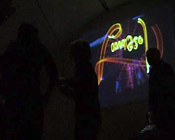
PIPS:lab : luma2solator
exhibition / presentation (2004. 10. 22.)This is an installation which invites the audience to create their own lumasol lightgraffities (A lumasol–lightgraffiti is a photograph recorded with a long shutterspeed). The visitor can make during a timespan of thirty seconds, a drawing with spraycans that produce light (The build-in flash makes it possible to not only see the lightgraffity but also the creating artist). A soundtrack offers the visitor instructions of how the machine is operated. The result is immediately visible on the 21-inch build-in monitor. If there are no lightgraffities being made the device automatically show a collection of already made lightgraffities that are saved in the lumasol hall of fame. more... -
Siegfried Zielinski: Speed and Energy
lecture (1998. 03. 26.)As a special guest of C3, media archaeologist Siegfried Zielinski will make his presentation zapping back and forth between the avant-garde of the 1920's and our present-day technological frontier, with a multi-textural examination of the shifting borders of cutting-edge science and art. Within the lecture excerpts of the following films, among others, will be presented: Viking Eggeling: Diagonal Symphony; Walter Ruttmann: Opus (II-IV); Férdinand Leger: Le Ballet Méchanique; Dziga Vertov: Man with a Movie Camera; Luis Bunuel/Salvador Dalí: Un Chien Andalou. more... -
Ilona Kovács: Capturing Time: From E. J. Marey to Modern Neuroscience
lecture (2010. 10. 20.)How does a good representation of the intricate movements of living things look like? Can we turn all movements of biological origin visible and measurable in spite of their fast speed and spatial complexity? How does the brain represent dynamic information about moving objects and other moving creatures? Our psychophysical studies show that the representation suggested by Marey might be used by the brain as well. We employed a psychophysical reverse mapping technique (Kovács & Julesz, Nature, 1994) to study the global interaction pattern of a large number of neurons responsible for low-level visual coding in the brain. more...
